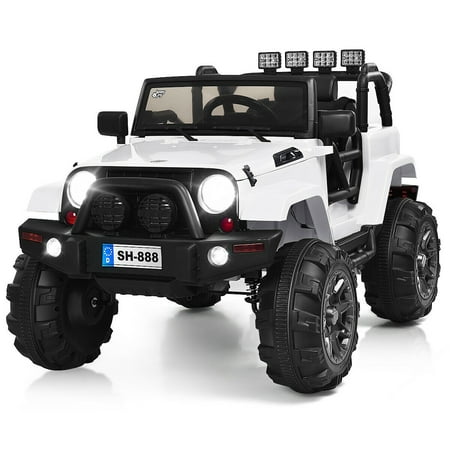12V Kids Ride On Truck Car w/Bluetooth Remote Control MP3 Music LED Lights
Notice: Not sold to consumers located in California This is our kids ride on truck which is the perfect gift every child will be sure to love! This electric toy provides a fun driving experience for children, utilizing two motors powered by 12V 7AMP battery. It comes with realistic car details that your kids will surely love: uniquely designed look, MP3 player, music &horn sound, forward &reverse function, and lights that turn on and off, etc.. Children can drive themselves, or can simply enjoy a trip while parents control it using a remote control. It must be mentioned that soft start function and spring suspension system further ensure the safety of children driving. Bring healthy and more wonderful childhood to your children. Don’t hesitate to buy it! Feature: Cool appearance that attracts children’s eyes MP3 Player: equipped with AUX input, USB port & TF card slot, connect your device to play music or stories, ride more enjoyable Soft start function for gradual acceleration and reliable braking Spring suspension system for a super smooth ride Parental remote control mode & battery operate mode With a 2.4 GHZ bluetooth remote control Forward & reverse functions, 3 speeds on remote control for adjustment Double door with magnetic lock, bright front & rear LED lights Comfortable seat with multi-point safety belt, large space to sit and play Wear-resistant and explosion-proof wheel PP wheels, no need to inflate Portable design, built-in handle for easy movement Portable design, built-in handle for easy movement A perfect gift for children, provides healthy exercise and plenty of fun Naturally develop hand-eye coordination ability in play and laughter Adjustable volume design Specification: Assembly required Color: BlackPinkWhite Main Material: PP + Iron Overall Dimensions: 46.5”x31”x29”(LxWxH) Net Weight: 35 lbs Weight Capacity: 66 lbs Speed: 3-6 km/h Charge Time: about 8-12 hours Battery: 12V 7AHx1 Motor: 12Vx2 Recommended for ages: 3-7 years old Certification: UL Package Includes: 1x kids ride on truck 1x 2.4GHZ remote control 1x charger 1xinstruction















Reviews
There are no reviews yet.